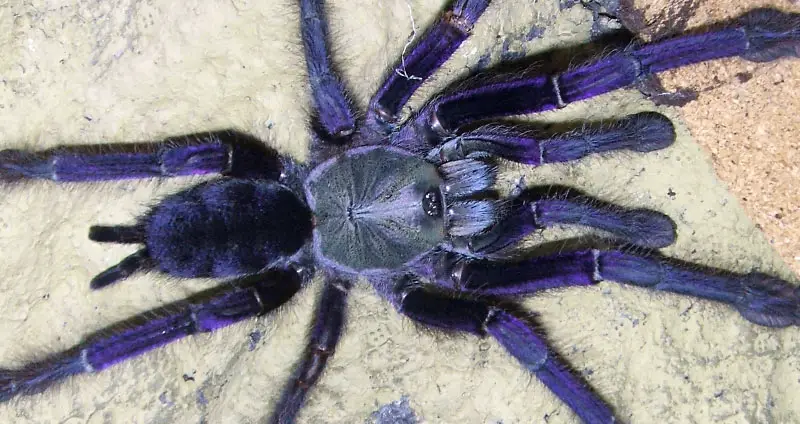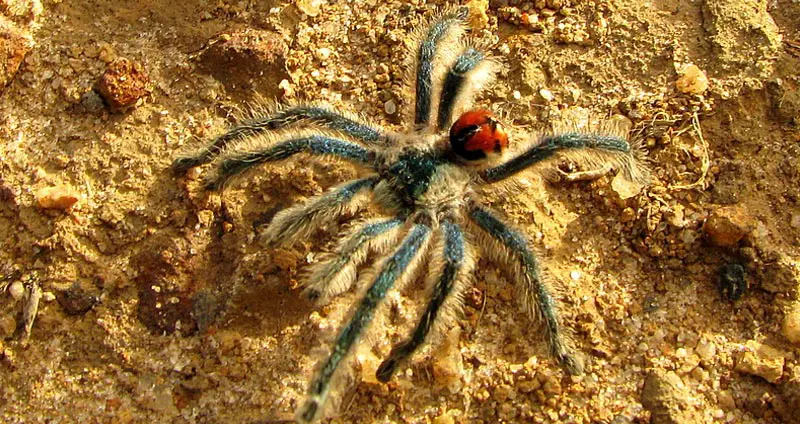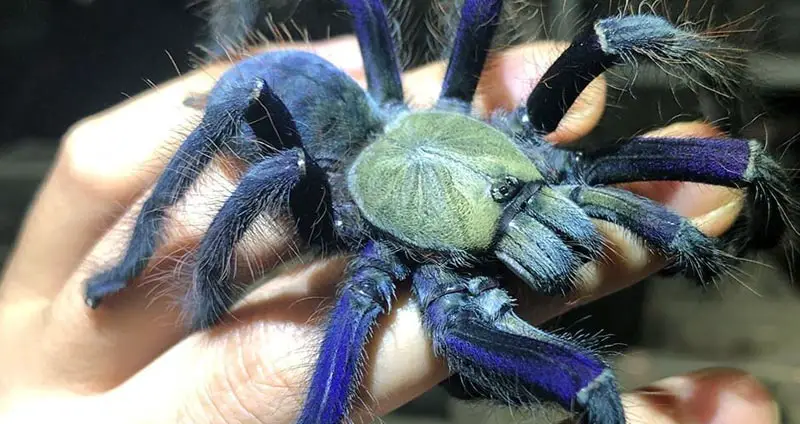Out of the over 800 types of tarantula known to science, the Lampropelma violaceopes is certainly one of the best looking and most interesting.
The Singapore Blue is a beautiful species that comes from the wetlands of Singapore and Malaysia. It has a stunning blueish-purple appearance, which is rightfully its trademark.
In this care sheet, we’ll talk some more about what makes the Lampropelma violaceopes special, and how to best go about caring for it.
Table of Contents
Lampropelma violaceopes Care Sheet
| | |
Common Name |
Singapore Blue |
Species Type |
Old world arboreal |
Natural Habitat |
Found in the jungles of Singapore and Malaysia. |
Growth Rate |
Medium growth rate. Grows at an average pace, but takes a while to reach full size due to its larger legspan. |
Adult Size |
Females reach a legspan of up to 9″, with males only measuring slightly smaller. |
Lifespan |
Females live for up to about 15 years, while males only live to about 4 years. |
Enclosure |
The enclosure should be taller than it is wide, with plenty of materials to climb on. It’s important to match the enclosure to the natural habitat of this tarantula. Two inches of substrate should line the floor, and water should always be available. The enclosure should have good airflow. |
Temp/Humidity |
75°F to 82°F with about 70% to 80% humidity. |
Diet |
A ravenous eater that can eat about an adult cricket every day. Its diet can also be supplemented with dubia roaches and mealworms. |
Temperament |
Aggressive, but not extremely so. Will throw up a threat pose or bite when threatened, but prefers to avoid confrontation in general. |
Experience Level |
Intermediate – Not very hard to care for, but its temperament makes it difficult to own. Not great for beginners. |
Average Cost |
Slings ~ $35, Males ~ $50, Females ~ $100+ |
Lampropelma violaceopes Appearance
The Singapore Blue tarantula is one of the largest arboreal species. It’s a leggy tarantula with a slim body — a physique that certainly contributes to its speedy and swift movements.
Spiderlings are relatively large, grow quickly, and still have the distinctive blue coloration of this species.
Both males and females have the same purplish-blue color, but something interesting happens to the male as it reaches complete maturity. It actually loses its deep blue distinctive coloring and becomes a flat shade of greenish-yellow.
The males are much smaller in size and have shorter lives than the female Lampropelma violaceopes, so you can enjoy their company for about 4 years. They’re still among the top choices for tarantula keepers because of their attitude and relative longevity.
The fully grown female Lampropelma violaceopes leg span reaches about 9 inches and they live for up to around 15 years.


Lampropelma violaceopesTemperament
Old world tarantulas are well-received by experienced tarantula keepers for a reason. There’s never a dull day around these feisty predators. Lampropelma violaceopes tarantulas are natural hunters and they look good while doing it.
They spend most of their day out in the open, climbing around their enclosure or just hanging on the side. This makes them a great display tarantula — one that enthusiasts love to have in their collection.
Unlike new world tarantulas, they don’t have urticating hairs, so their only natural defense mechanism is dealing a mean bite. This species isn’t exactly jumping at the opportunity to bite, but if they feel unsafe or in any way provoked they definitely will bite.
The venom of Lampropelma violaceopes is serious business. Besides the extremely painful sting, it could cause severe muscle spasms, a burning sensation around the bite, headaches, and a host of other symptoms resembling those of the flu.
That’s why we usually advise against handling your tarantula with your bare hands or even coming too close to it. The risks of close handling extend to the tarantula as well. If you’re bitten, the nature response is to fling the tarantula off of you. As you can imagine, this isn’t optimal.
To keep all parties involved in good health, this tarantula should just be admired from a safe distance. Fortunately, with its good looks, this isn’t hard to do!.
Another remarkable pastime for Lampropelma violaceopes is making elaborate webs. This means that providing plenty of climbing areas and anchor points for webbing is very important.
Housing Lampropelma violaceopes
It’s not very hard to keep an arboreal tarantula happy, and the Lampropelma violaceopes would be content with the bare necessities.
The perfect enclosure for a Singapore Blue is one that mimics its natural habitat. Since these tarantulas come from rain forests, then that’s what you should aim for — humidity and climbing space.
Optimal Lampropelma violaceopes Enclosure
The best enclosure for your tarantula is the one that fits its temperament, lifestyle, and biological needs.
Vertical height is the most important feature of an arboreal tarantula enclosure, but it also needs some horizontal space so that it isn’t restricted in its movement — especially for such a large tarantula.
The recommended enclosure for a mature Lampropelma violaceopes is the Exo Terra 18” x 18” x 24” glass terrarium.
We recommend this enclosure because it’s very spacious, well-built, provides great visibility, and allows for adequate cross-ventilation — all very important aspects of an enclosure.
Enclosure Decorations
While the enclosure itself is very important, the internal decor is also something that needs to be considered. There are a few supplies that Lampropelma violaceopes requires.
Singapore Blue tarantulas need substrate lining the bottom of their enclosure. This serves several purposes ranging from comfort to structure to humidity retention. They don’t need a deep layer like terrestrial species, so two inches of substrate is often enough.
From there, build up a vertical structure. You can utilize any convenient DIY material, but we prefer cork bark. You also need to include a hide for this skittish spider. It’s best to add a fake plant as well.
Remember to add a water bowl for your Lampropelma violaceopes. It’s absolutely essential for maintaining humidity and keeping the tarantula well hydrated.
Enclosure Humidity/Heating
Tarantulas are hardy creatures, and they can take a wide span of temperatures and environmental conditions. However, it’s best to mimic the humidity and temperature of their geographic origin.
Otherwise, their metabolism, appetite, growth rate, and even temperament could be negatively affected.
The Lampropelma violaceopes comes from a hot humid habitat, so it would fare best around a temperature range from 75°F – 82°F, with a humidity of around 70% – 80%.
If you live in a colder climate and need extra heating for your tarantula, you can provide supplemental heating through either a space heater or a gentle heat lamp that doesn’t emit light.
Keeping the enclosure humid isn’t that hard — the water bowl does most of the work. To complement its effect you can also mist the enclosure with a water sprayer if you notice that it’s getting dry.
This species doesn’t like wet substrate, though, so keep conditions moderate.
It’s practical to invest in a digital temperature/humidity gauge. This way, you’ll be able to monitor the enclosure’s conditions and make adjustments as necessary.
Diet
Lampropelma violaceopes Tarantulas often have healthy appetites, and they enjoy hunting and ambushing their prey. Even the little spiderlings are keen on food.
Singapore Blue tarantulas like locusts, crickets, moths, roaches, and beetles. You can buy several types of food, keeping in mind that the feedings should be age-appropriate, nutritious, and easy to culture.
These spiders are large and powerful, so you can throw in the occasional lizards and mice (as long as they’re smaller than the T itself). They’d put on a good show while hunting these.
Appetite is a good indicator of their health and growth stage. If your tarantula stops eating altogether, it might be getting ready to molt. You need to leave it alone at these times.
Health Concerns
Tarantulas are tough creatures. As pets they aren’t very needy and, with a few careful considerations, you can enjoy their company for a long time.
The most important aspects of keeping a tarantula are ensuring that it has an optimal enclosure (in terms of size and climate) and providing it with a complete diet.
There are two concerns though that you should be aware of — a tarantula becoming dehydrated or falling victim to a mite infestation. Both are often treatable and avoidable, fortunately.
You should also make sure that your Lampropelma violaceopes has enough vertical and horizontal spaces. Tarantulas in very tight spaces don’t often bode well.
Lampropelma violaceopes For Sale & Price
The Lampropelma violaceopes tarantula is pretty but not too rare. It’s not one of the most expensive tarantulas, but it’s not cheap either. Keepers think of it as a good catch, as it has stunning looks, a great attitude, and usually lives for a long time.
Depending on whether you’re buying slings, males, or females, prices vary greatly. Spiderlings can be purchased for around $35, while males often fetch around $50 and females fetch between $100 and $300 depending on their size.
Adding this cost to the other costs of tarantula ownership, a healthy Lampropelma violaceopes can fetch a pretty penny. However, this price is well worth it for such a stunning and interesting tarantula species.

